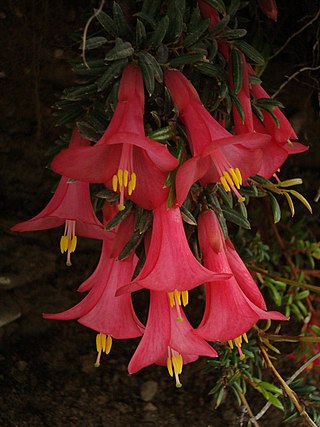
Spirostachys is a plant genus of the family Euphorbiaceae first described as a genus in 1850. It is native to Africa. Zuloaga, F. O., O. Morrone, M. J. Belgrano, C. Marticorena & E. Marchesi. (eds.) 2008. Catálogo de las plantas vasculares del Cono Sur. Monographs in systematic botany from the Missouri Botanical Garden 107(1–3): i–xcvi, 1–3348.

Philesia is a South American genus of flowering plants in the family Philesiaceae first described as a genus in 1789.

Galium divaricatum is a species of flowering plant in the coffee family known by the common name Lamarck's bedstraw.

Bahia ambrosioides is a South American species of flowering plants in the family Asteraceae. It is native to Chile including the Juan Fernández Islands.
Oplismenopsis is a genus of South American plants in the grass family. The only known species is Oplismenopsis najada, native to southern Brazil, Uruguay, and northeastern Argentina.
Neobouteloua is a genus of Argentine and Chilean plants in the grass family.
Eriachaenium is a genus of South American flowering plants in the family Asteraceae.
Dolichlasium is a genus of flowering plants in the family Asteraceae.
Duseniella is a genus of Argentine flowering plants in the family Asteraceae.
Gamochaetopsis is a genus of flowering plants in the daisy family.
Gypothamnium is a genus of South American flowering plants in the family Asteraceae.
Huarpea is a genus of flowering plants in the family Asteraceae.
Paleaepappus is a genus of flowering plants in the aster tribe within the sunflower family.

Hippeastrum aulicum, the Lily of the Palace, is a bulbous perennial, in the family Amaryllidaceae, native to the Atlantic Forest and Cerrado ecoregions from Brazil to Paraguay, in South America.

Hippeastrum cybister is a flowering perennial herbaceous bulbous plant, in the family Amaryllidaceae, native from Bolivia to Argentina.

Heterostachys is a genus of flowering plants in the plant family Amaranthaceae. The two species are shrubby halophytes native to South America and Central America.
Guynesomia is a genus of Chilean flowering plants in the tribe Astereae within the family Asteraceae.

Ribes magellanicum is a South American species of shrubs in the currant family, found in Patagonia.

Rubus geoides is a South American species of flowering plant in the rose family. It has been found only in the extreme southern part of the continent, in the Provinces of Tierra del Fuego, Santa Cruz, Río Negro, and Neuquén in Argentina, the adjacent Magallanes Region of Chile, and the Falkland Islands.

Philodendron appendiculatum, also known as güembé, is a perennial species in the genus Philodendron, belonging to the family Araceae. It lives in the jungles, wetlands, and moist forests of South America.











